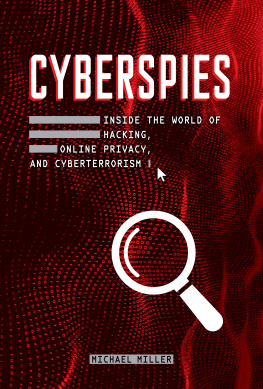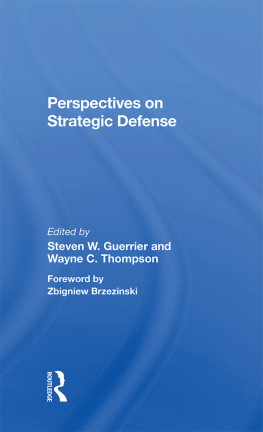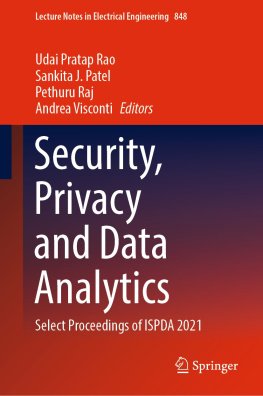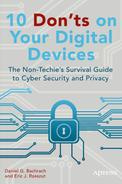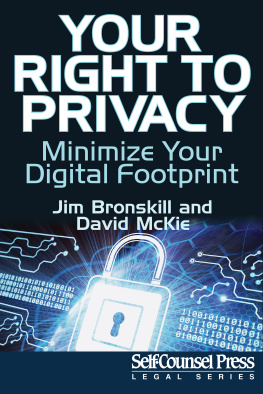Guerrier - Security and privacy in the digital era Volume 1
Here you can read online Guerrier - Security and privacy in the digital era Volume 1 full text of the book (entire story) in english for free. Download pdf and epub, get meaning, cover and reviews about this ebook. City: London;Hoboken;NJ, year: 2016, publisher: John Wiley & Sons, Incorporated;UK ISTE John Wiley & Sons Inc, genre: Romance novel. Description of the work, (preface) as well as reviews are available. Best literature library LitArk.com created for fans of good reading and offers a wide selection of genres:
Romance novel
Science fiction
Adventure
Detective
Science
History
Home and family
Prose
Art
Politics
Computer
Non-fiction
Religion
Business
Children
Humor
Choose a favorite category and find really read worthwhile books. Enjoy immersion in the world of imagination, feel the emotions of the characters or learn something new for yourself, make an fascinating discovery.
- Book:Security and privacy in the digital era Volume 1
- Author:
- Publisher:John Wiley & Sons, Incorporated;UK ISTE John Wiley & Sons Inc
- Genre:
- Year:2016
- City:London;Hoboken;NJ
- Rating:5 / 5
- Favourites:Add to favourites
- Your mark:
- 100
- 1
- 2
- 3
- 4
- 5
Security and privacy in the digital era Volume 1: summary, description and annotation
We offer to read an annotation, description, summary or preface (depends on what the author of the book "Security and privacy in the digital era Volume 1" wrote himself). If you haven't found the necessary information about the book — write in the comments, we will try to find it.
Guerrier: author's other books
Who wrote Security and privacy in the digital era Volume 1? Find out the surname, the name of the author of the book and a list of all author's works by series.
Security and privacy in the digital era Volume 1 — read online for free the complete book (whole text) full work
Below is the text of the book, divided by pages. System saving the place of the last page read, allows you to conveniently read the book "Security and privacy in the digital era Volume 1" online for free, without having to search again every time where you left off. Put a bookmark, and you can go to the page where you finished reading at any time.
Font size:
Interval:
Bookmark:

Innovation and Technology Set
coordinated by
Chantal Ammi
Volume 1
Claudine Guerrier

First published 2016 in Great Britain and the United States by ISTE Ltd and John Wiley & Sons, Inc.
Apart from any fair dealing for the purposes of research or private study, or criticism or review, as permitted under the Copyright, Designs and Patents Act 1988, this publication may only be reproduced, stored or transmitted, in any form or by any means, with the prior permission in writing of the publishers, or in the case of reprographic reproduction in accordance with the terms and licenses issued by the CLA. Enquiries concerning reproduction outside these terms should be sent to the publishers at the undermentioned address:
ISTE Ltd
27-37 St Georges Road
London SW19 4EU
UK
www.iste.co.uk
John Wiley & Sons, Inc.
111 River Street
Hoboken, NJ 07030
USA
www.wiley.com
ISTE Ltd 2016
The rights of Claudine Guerrier to be identified as the author of this work have been asserted by her in accordance with the Copyright, Designs and Patents Act 1988.
Library of Congress Control Number: 2016943714
British Library Cataloguing-in-Publication Data
A CIP record for this book is available from the British Library
ISBN 978-1-78630-078-2
If Marx were to return, which phenomenon would he use to characterize todays society? It would no longer be capital or capitalism, but rather the development of technique, the phenomenon of technical growth, strategic analyses that commercial societies carry out to determine whether certain patents should have a limited reach, within one or several states, or whether they should reach a number of countries. Machines are often mobile: from 1980 onward and especially from the start of the 21st Century they are nearly always mobile, participating in a level of control that the users are not always aware of, or to which they are consciously indifferent. This is what appears in the profiling of populations [MAT 14], which breaks down and analyzes the outlines and dynamics of post-Orwellian surveillance, and sometimes even cyber surveillance.
For several decades now we have been living in the digital age. Digitization is relevant to nearly all tools and machines. Development must occur digitally. In the domain of electronic communication, where audiovisual technology is joined to telecommunications and informatics, digital technology prevails. In France, the 2016 law on digital technology was one of the most important legal contributions provided by the Valls government, and came after consultation of the various parties involved. Very high speed broadband is an objective for both states and companies. Many nations of Eastern Europe, including those previously belonging to COMECON, have successfully focused on the growth of fiber optics to compensate for their bad start with the triumph of the copper pair in Western Europe. Lithuania was ranked first among European countries in terms of the penetration of fiber optics in its plastic form or as a glass fiber, while the United Kingdom and Germany, where the copper pair had previously allowed for the installation of comprehensive networks, were placed outside of the rankings. This is also the case in Estonia, Poland and Russia (not in the European Union), and even Belarus. The European Union has established a plan for the growth of very high speed broadband that is to be finalized in 2020, which seems optimistic. European funds were made available, but have since been reduced as a result of the levels of debt that are affecting nearly all European states. The governmental public subsidies are more readily approved by the Commission when the country in question belongs to the old Soviet block, which converted to a market economy only 25 years ago, than when the country has belonged to the liberal sphere for much longer. With regard to mobile phones, while research on 5G has progressed considerably, most private telecommunication operating companies in the developed world use 4G licenses. Digital technologies are a prominent factor for growth, but the digital divide is still a reality in Africa, despite being presented as a continent that is favored for development. With regard to fiber optics, this divide is obvious between highly urbanized areas and medium-density or low-density areas. The question is whether territorial collectivities can play an active role in the complex situation. In France, since LCEN, territorial collectivities are not only able to develop networks which they have been able to do since 1999 because of the general code of local collectivities but can also be network operators. Also in France, local collectivities have been granted WIMAX licenses. However, the same choice has not been given in all countries of the European Union, which, as part of a neo-liberal agenda, encourage an informed distrust of public collectivities if they are regions participating in the exploitation of networks, or even of communication services. The Treaty on the Functioning of the European Union, following previous treaties that constitute it, allows for a reasoned and argued amount of leeway in terms of services of general interest, which could be technical or economic exceptions, not only for digital technologies, but also other technologies that are likely to boost the market and competition.
Digital technologies are a dominant factor among those that shape us and that we govern (unless it is these technologies that govern us). Nanotechnology is a technology that affects the state of the environment, whether these be techniques that use renewable energy or technology that deals with the various forms of the ecosystem, plant, mineral or animal matter, join together digitally to substantiate commercial exchanges between long industrialized countries or those only recently so, between emerging countries not only Brazil, Russia, India, China and South Africa (BRICS), but also Indonesia, South Korea, Mexico, Turkey, Saudi Arabia, members of the G20, between developing or even underdeveloped countries, but with investment zones that allow for interesting and worthwhile returns on investment. The techniques, often coupled with services, are therefore at the heart of the system as described by Ellul which has an economic dimension, but also a legal dimension, with a strong focus on legal rationalization, and a geopolitical dimension, since technicist systems also involve a military dimension, with satellites and drones that draw upon a civil and commercial aspect as well as a military one, linked to a military industrial complex, not only in the United States, and to alliances where the United States continues to play a determinant and predeterminant role in the context of NATO, but also with states that are not members of the North Atlantic Treaty Organization (NATO), but which rely on the help of NATO on multidimensional issues that pit them against other entities, states, international organizations, lobbies and various diverse companies.
The techniques and technologies mentioned above can be exploited with the goal of commercial benefits, but they can also be used for the upkeep of national security and public order. They have a lot of potential in terms of surveillance and control. As such, with regard to secret correspondence, postal letters could be opened and read, in the French Cabinets Noirs in the 19th Century, for example. In Lucien Leuwen by Stendhal, the interception of a telegraph results in the winning of an election. At the end of the 20th Century, a landline telephone could be listened on legally in certain cases. With the popularization of personal computers and mobile telephones, it has become much easier for citizens to communicate among themselves; it is also much easier for the State to intercept various methods of communication through conversations, e-mails, text messages, etc. The materials used are cheaper, as are the methods of interception. At the end of the 20th Century, operators carrying out interceptions legally have often come up against the Ministry of the Interior and the Ministry of Justice, as these interceptions, which constituted a public service, were deemed underfunded in the eyes of those with a background in private law, as much in the United States as in other developed countries. Public authorities, attempting to protect taxpayers money and the government coffers, found themselves in contradictory positions, and negotiations were long and difficult. In the 21st Century, the price of an interception is much lower and as such the number of interceptions is always increasing. The search for profit is identical for commercial societies, but the context is less rigid, and negotiations between operators working for the State and the State itself are less difficult. The interception of electronic communications is a field that has progressed, but the methods of interception have existed for a long time.
Next pageFont size:
Interval:
Bookmark:
Similar books «Security and privacy in the digital era Volume 1»
Look at similar books to Security and privacy in the digital era Volume 1. We have selected literature similar in name and meaning in the hope of providing readers with more options to find new, interesting, not yet read works.
Discussion, reviews of the book Security and privacy in the digital era Volume 1 and just readers' own opinions. Leave your comments, write what you think about the work, its meaning or the main characters. Specify what exactly you liked and what you didn't like, and why you think so.


